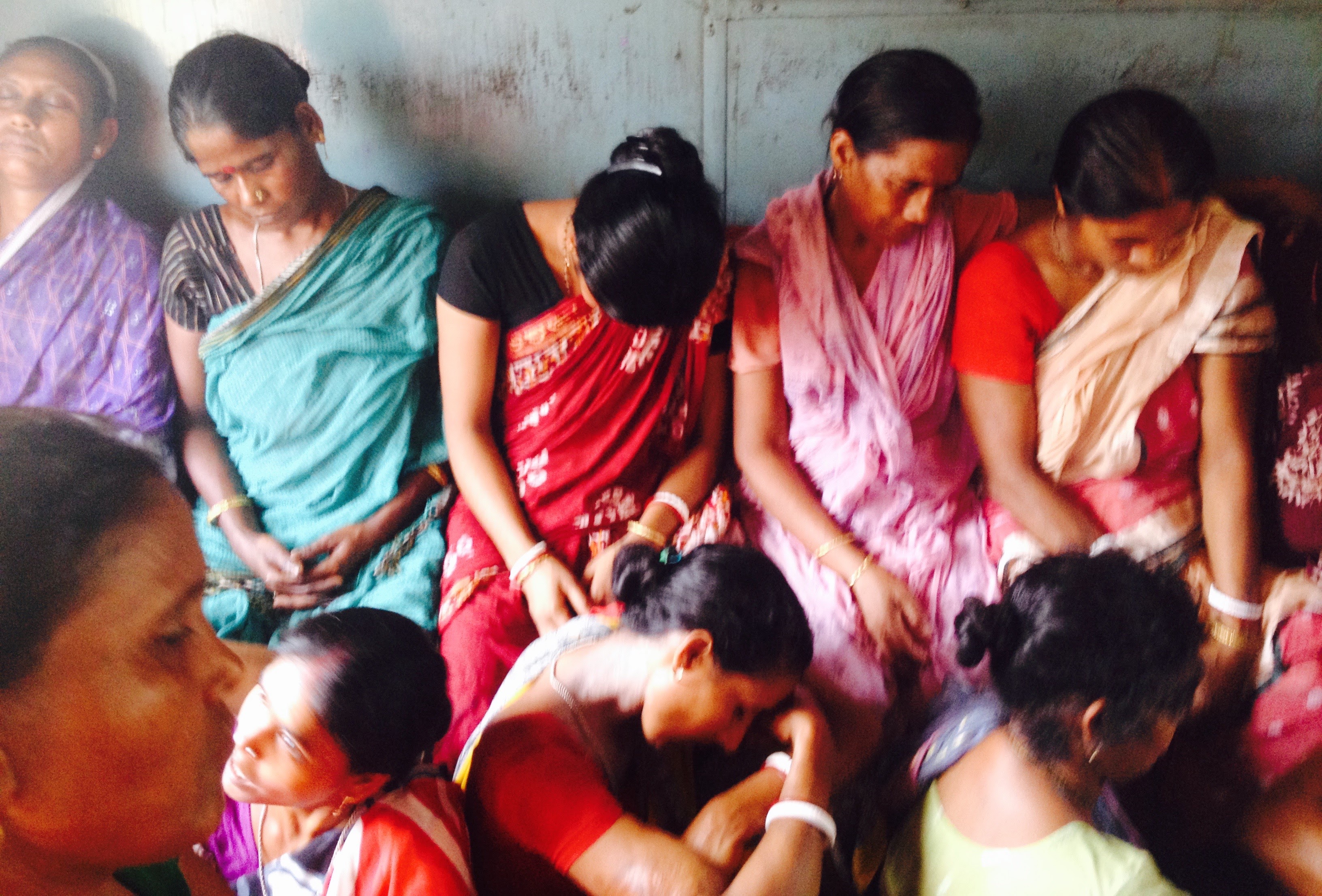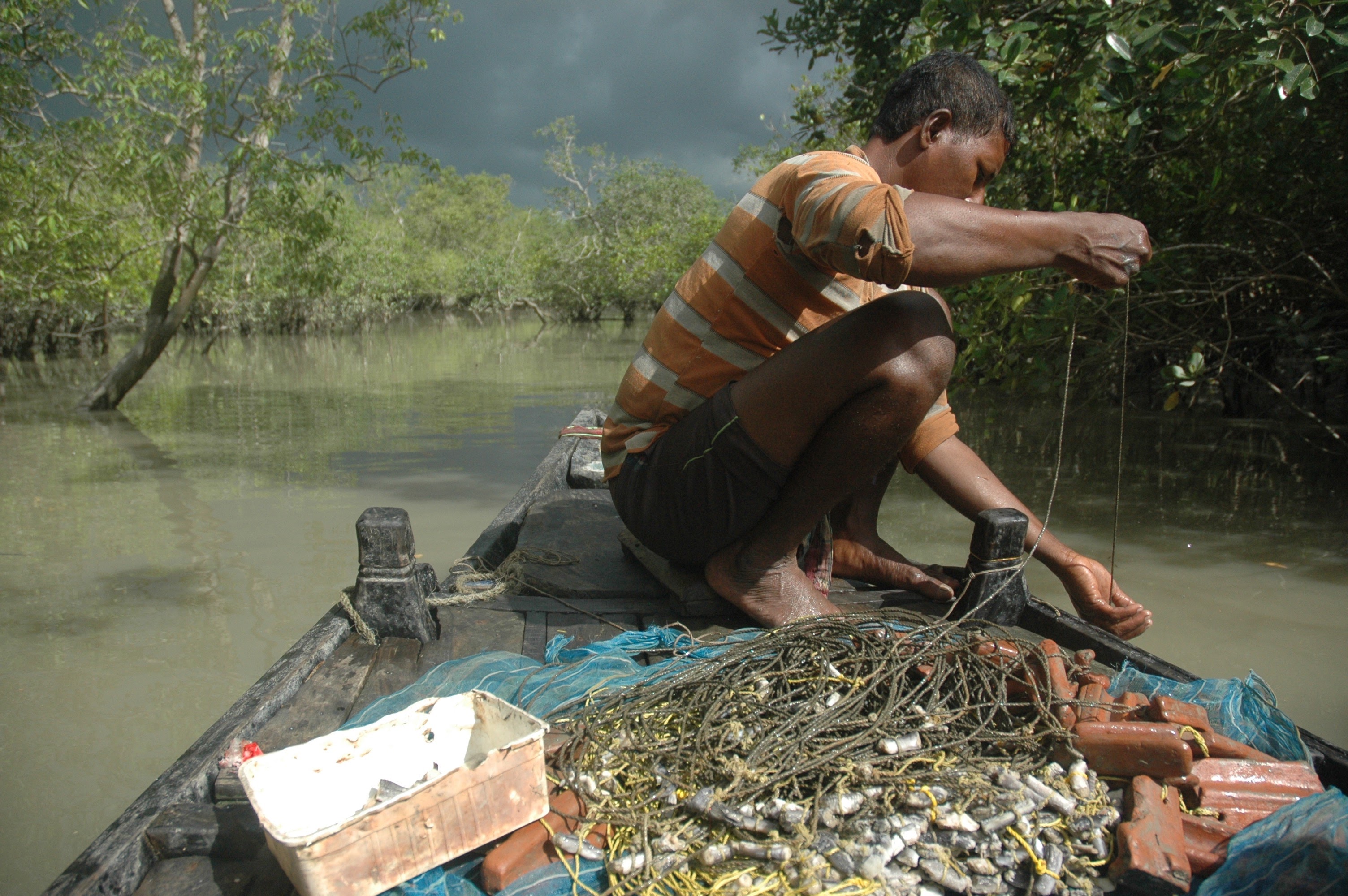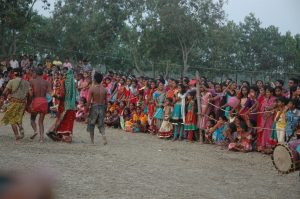This is the second of a two-part series on a plan to relocate populations from the Sundarbans in the Bay of Bengal, the world’s largest mangrove delta. Read the first part here.
The authors of the Delta Vision 2050 who are proposing managed retreat from the Sundarbans see other challenges to their vision including the unwillingness of the islanders. While we would argue that any plan for managed retreat should pay attention to what people want, what is perhaps less obvious is the diversity of desires, which development workers often read as the failure of consensus building. Sometimes residents are forging different paths, often from within the same neighborhood. The very few local elites of the region are managing their own retreat and have increasingly begun to acquire two bases: a home in the Sundarbans and another in towns neighboring Kolkata such as Canning and Sonakhali.
Yet, Piyali Mondol, an unmarried woman and one of four daughters who collects crabs for a living in the mangrove creeks opposite her home, cannot afford to move. Nor does she want to. It was only last year that Mondol managed to save enough money to convert her mud hut into a brick home. Cyclone Amphan cracked the roof of her house and will potentially send her into a cycle of debt. Most of the population in her island share her fate – they are landless fishing communities and some only have squatter’s rights. They don’t have independent means to leave the Sundarbans or buy lands on higher ground. If the government were to ever come to buy them out for relocation, they will have no land to offer – deepening their precarity even further.
The biggest threat Mondol faces is the Forest Department. Wildlife and conservation laws, starting with the Wildlife Protection Law of 1972, have transformed residents of the Sundarbans into encroachers for inhabiting areas designated for the protection of the Bengal tiger. Intensive policing has turned Mondol from being a custodian of the forest to a trespasser there. These attempts to fence off the forest are both detrimental to the foresters and simultaneously compromise biodiversity. Such conservation methods tend to ignore that forests are also products of human labor and interaction.
In the past decade, in order to “wean” Mondol off her “forest-dependency,” several conservation NGOs have given her free chickens and ducks to rear. On the receiving end of a series of development projects, Mondol must negotiate between the “good” livelihood of raising chickens versus the “bad” choice of going to the forest. Planned retreat would discipline such patterns of forest dependency by relocating Mondol to a peri-urban location. Mondol is well aware of the crossroads that lie ahead of her. With the onslaught of more cyclones and storms to come, she says, “No, I do not want to leave. I like it here… the city, with its cars and sounds make me want to vomit.” She only wishes to escape the surveillance of the Forest Department and remain in the mangroves. As her neighbor points out: “It is not the tiger that is killing us, it is the fear of the Forest Department that forces us into the mouth of the tiger.”
Upon asking Mondol about potential future storms that might do even more damage than Amphan, her response echoes that of several others, including Bimla Sarkar. She replied: “let another storm come… we were born here and will die here … what can we do? Our life is cheap. They [the government] haven’t even built us a hospital here.” No one is yet asking what futures in the Sundarban would look like if provisions for basic services and infrastructures were brought to the islands. The majority of Sundarban residents have an attachment to home, a community of relatives and neighbors, and the daily rhythms of life alongside a forest and the accompanying village festival calendar.
Taruq Mistry, on the other hand, imagines his future differently from Mondol and Sarkar. He is in his mid-30s with two young children and makes a living by working as a daily wage field laborer. Mistry desires a different home elsewhere – but one with access to a livelihood. With a stable source of income, he hopes to be able to provide a better education to his children than the one he had access to while growing up. With relation to planned retreat, he responded by saying, “The government would never do that, but if they did, I would go… I don’t want to live here anymore. There are more jobs in [the southern Indian states of] Kerala and Tamil Nadu, here we have no jobs.” But leaving is not that easy for Mistry either. While he is drawn to the life in the city and its opportunities for work, he was aware that his wife desires no such move. The last time they were in the city for a medical visit, commuting on a train or bus made her sick, and the food, water, and air in the city didn’t suit her. Besides, the two have ailing and elderly parents in the Sundarbans who would not be able to leave the moist airs of the mangroves for the smog of the higher grounds.
Yet no one knows if the next cyclone might be the one that shifts Mondol’s desires and make her want to leave. Likewise, one cannot ever discount the fact that after a few years on a factory shop floor in Tamil Nadu, Mistry might want to return to his village. What we heard was not the lack of consensus building or the awareness of climate threats, but a crucial and overlooked aspect of the lives of residents of the Sunderbans: the provisioning of basic infrastructure for a dignified life. A thread that runs through the residents’ aspirations is that they want to escape from the lack of basic necessities as much as — if not more than — they want to escape the rising waters. If Mondol wanted hospitals, Mistry wanted opportunities for work and access to better education for his children — none of which they felt the government would grant them in the delta or elsewhere.

Commuters on the train from Kolkata to Canning (Photo: Megnaa Mehtta)
Moving People
Independent India is familiar with mass displacement of population in the name of development. India’s experiment with industrial modernization meant homelessness for thousands of people in independent India, who were forced to remake their lives in urban and peri-urban areas “housed in furnace-like metal shacks and remade as laborers in a wage economy.” Sundarban itself is no stranger to the violence of displacement. The memory of the 1979 massacre in an island named Marichjhapi is all too alive.
The island of Marichjhapi was being used by the Forest Department for coconut plantations when lower-caste refugees from Bangladesh, who were promised and then denied resettlement by the West Bengal Left Front government, began making a home on the island. In 1979, the West Bengal government decided to forcibly clear the island of the new settlements. Recounting the massacre from oral histories of survivors, the number of people killed and thrown into the Rai Mangal river is in the thousands, in contrast to the Indian government’s official estimates that put the death toll in the dozens. This tragedy shows how the state gave primacy to ecology and revenue generation over people. Is planned retreat again pitting the health of the forest against its custodians?
There have recently been experiments with managed retreats globally, often led or lobbied for by the Dutch. The Dutch Room For River Project, which was conceived in 2007 and completed in 2015, has been hailed as a pioneering success in managed retreat. With a budget of 2.2 billion euros, the Dutch began to protect flood plains and create spaces for the river to flood. In the process, they moved away from policies of raising the dykes in some parts of the floodplains in and around the town of Nijmegen. While not every resident whose house was demolished was happy about the outcome, the project has been hailed a success and is now being either replicated or considered in many parts of the world threatened by floods. The Indonesian President Joko Widodo’s announcement to move the capital away from the sinking space of Jakarta is the latest managed retreat. Nineteenth-century Dutch colonialism created the water crisis for Jakarta and now contemporary Dutch global water governance brings it the solution.
In some instances, retreat has been the product of collective organizing as in the low-lying Beachwood community in Staten Island, a predominantly white borough, which lobbied the governor of New York to have their homes bought out by the government and allow them to relocate elsewhere. This began the process of unbuilding the South Shore as a floodplain for future storms. Managed retreat in North America is a story of race too. While there has been successful community organizing for retreat, predominantly in white floodplain communities, that is not the case for instance in the disappearing marshlands of Isle de Jean in New Orleans, which was destroyed by the oil industry, and whose inhabitants are mostly members of the Biloxi-Chitimacha-Choctaw tribe. Tribe members want to remain and hold onto their way of life in the marshes, even though they have to gradually raise their homes as the waters steadily rise. They would rather have the oil companies retreat so that they can continue with their marshy lives.
The conflict here is not simply between the sinking marshes and rising waters, but between two economic arrangements of space: flourishing from subsistence fishing and foraging versus profiting from fossil fuel extraction. Climate policy discussions often fail to substantially engage with the economic arrangements of subsistence versus capitalist growth and productivity when it comes to spaces like the low-lying Tuvalu in the Pacific. Carol Farbotko, who is a cultural geographer by training, has termed climate policy discussions over Pacific islands as “wishful sinking.” The Pacific Islands have become sites of global climate anxiety and experiments projected onto an uneven economic geography. Their disappearance index both the evidence of climate change for climate deniers in Northern nations as well as the tragedy unfolding for the global commons.

Eking out a living in the mangrove creeks (Photo: Megnaa Mehtta)
When the Water Comes
Planned retreat in the Sundarbans will funnel fishers, foresters, and honey-collectors into the dust-laden air of the neighboring city of Kolkata, to become low-wage workers in the building and construction industry. The real-estate boom in Kolkata, which is fast gobbling up the critical wetlands on the edge of the delta, will further devastate the mangroves by altering the hydrological structure of the region.
A different future is possible in the Sundarbans if we carefully listen to Piayli, Tarqu, and Sarkar. We have to rethink governance as a community asset: Whereby Sundarbans residents can be given the capacities to maintain their own embankments, build houses attuned to their own knowledge systems, and use the fruits of the forest through ideas of collective ownership. There is a long history of people who saw the landscape as flood dependent, rather than a flood risk. They knew how to move with the river, cultivate newly formed fertile alluvial mudflats, and sustain themselves from the thriving mangroves.
Climate change has offered us a frame to make sense of the mobile landscape as one vulnerable to the furies of wind and tides. But land here has been moving for a long time, perhaps at a slower pace than our current moment. For instance, it did not escape the notice of 19th century British geologists who marveled and shuddered at how land in the Bengal delta is in a constant state of flux sculpted by the moods of the river and the sea. Farmers often call their flooded paddy fields teeming with fish life jami jalajanta in Bengali – land brimming with life. Rhythms of the sea, the moving mangroves, and the river define their relation to the land and shape their livelihood.
The forest of the Sundarbans is known by residents who live alongside it as “Ma’ar Khamor,” which literally translates into “mother’s pantry” – the mother here is the forest goddess Bonbibi and her forest is thought of as a “commons in times of need.” When we begin to treat islanders as custodians and not invaders of the forest, the paradigm of retreat would need to focus on the real threats to the delta – our carbon intensive livelihoods of concrete, cement, luxury cruises, fishing trawlers, and coal plants.
If Bimla Sarkar states after surviving a series of cyclones that the Sundarbans is where she was born and this is where she will die, could it be the case that her willingness to die in a certain way goes alongside a particular commitment to life? This is not just an idea of staying alive, but of living a fuller form of life, within her structural constraints, defined by her own parameters of what it means to live well and live autonomously.
Debjani Bhattacharyya is a historian and author of Empire and Ecology in the Bengal Delta: The Making of Calcutta (Cambridge 2018), which received the honorable mention for the best book in urban history in 2019. Her writings have appeared in N+1, The Telegraph, Somatosphere and Ananda Bazar Patrika.
Megnaa Mehtta is an environmental anthropologist whose research draws on long-term ethnographic fieldwork in the Sundarbans forests. Currently she is working on a book manuscript titled “Conserving Life: Political Imaginaries from a Forest”. Alongside her interests in mediating between lawyers, activists and conservationists, she has co-curated photo exhibitions, worked with film directors, and her research and writing has featured in several venues such as NPR, Himal South Asia and The Telegraph.
































